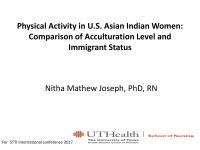| dc.contributor.author | Serafica, Reimund | en |
| dc.date.accessioned | 2012-09-12T09:18:49Z | |
| dc.date.available | 2012-09-12T09:18:49Z | |
| dc.date.created | Tuesday, July 31, 2012 | en |
| dc.date.issued | 2012-9-12 | |
| dc.identifier.uri | http://hdl.handle.net/10755/243194 | |
| dc.description.abstract | Purposes: The purposes of this study were to describe the relationship among demographic variables, level of acculturation, dietary consumption of fat, sugar, fruits and vegetables among Filipino- Americans(FAs) and to explore the predictors of their anthropometric measurements. The role of dietary acculturation and consumption of fat, sugar, fruits, and vegetables amongFAs in the United States (US) remains unclear. Despite the growing numbers of FAs in the US, little is known about their dietary acculturation and fat, sugar, fruits, and vegetable consumption. Methods: The study sample consisted of 128 FAs (N = 128) residing in US. Participants completed the demographics, the Block's Short Food Frequency Questionnaire (SFFQ), a Short AcculturationScale for Filipino Americans (ASASFA), and the Dietary Acculturation Questionnaire for Filipino Americans (DAQFA). Anthropometric measurements such as weight, height, waist and hip circumferences were also taken. Partial Least Squares (PLS) path modeling was used to explore the predictive relationships between dietary consumption and anthropometric measurements. Results: The most important positive predictors of the anthropometric indicators were the Western Scale (path coefficient = .503, > .05) and the intake of fats and sugars (path coefficient = .282, > .05). Fruit and Vegetables (path coefficient = -.034), Acculturation (path coefficient = .035), the Filipino Scale (path coefficient = -.086) and Demographic factors (path coefficient = .133) were not significant predictors of the anthropometric measures at the .05 level. Conclusion: The implications were that a high number of food items chosen from the Western Scale, in combination with an increased intake of fat and sugar, predicted a significant increase in body-mass index (BMI), waist-hip-ratio (WHR), and waist and weight circumference of participants. FAs should be encouraged to decrease their fat and sugar consumption in their diet. Nurses and family nurse practitioners who take care of FAs may suggest alternative meal options. | en |
| dc.format | Text-based Document | en |
| dc.language.iso | en | en |
| dc.subject | Filipinos | en |
| dc.subject | dietary acculturation | en |
| dc.title | Dietary Consumption of Fat, Sugar, Fruits and Vegetables and Anthropometric Indicators among Filipinos in U.S. | en |
| dc.type | Presentation | en |
| dc.rights.holder | <p>
All rights reserved by the author(s) and/or publisher(s) listed in this item record unless relinquished in whole or part by a rights notation or a Creative Commons License present in this item record.
</p><p>
All permission requests should be directed accordingly and not to the Sigma Repository.
</p><p>
All submitting authors or publishers have affirmed that when using material in their work where they do not own copyright, they have obtained permission of the copyright holder prior to submission and the rights holder has been acknowledged as necessary.
</p> | |
| dc.description.note | Items submitted to a conference/event were evaluated/peer-reviewed at the time of abstract submission to the event. No other peer-review was provided prior to submission to the Henderson Repository. | |
| dc.type.category | Full-text | en |
| dc.contributor.department | Mu Psi | en |
| dc.author.details | Serafica, Reimund, PhD, MSN, RN | en |
| dc.conference.name | 23rd International Nursing Research Congress | en |
| dc.conference.host | Sigma Theta Tau International, the Honor Society of Nursing | en |
| dc.conference.location | Brisbane, Australia | en |
| dc.date.conferenceyear | 2012 | en_US |
| dc.description.reviewtype | Abstract Review Only: Reviewed by Event Host | en |
| dc.description.acquisition | Proxy-submission | en |





